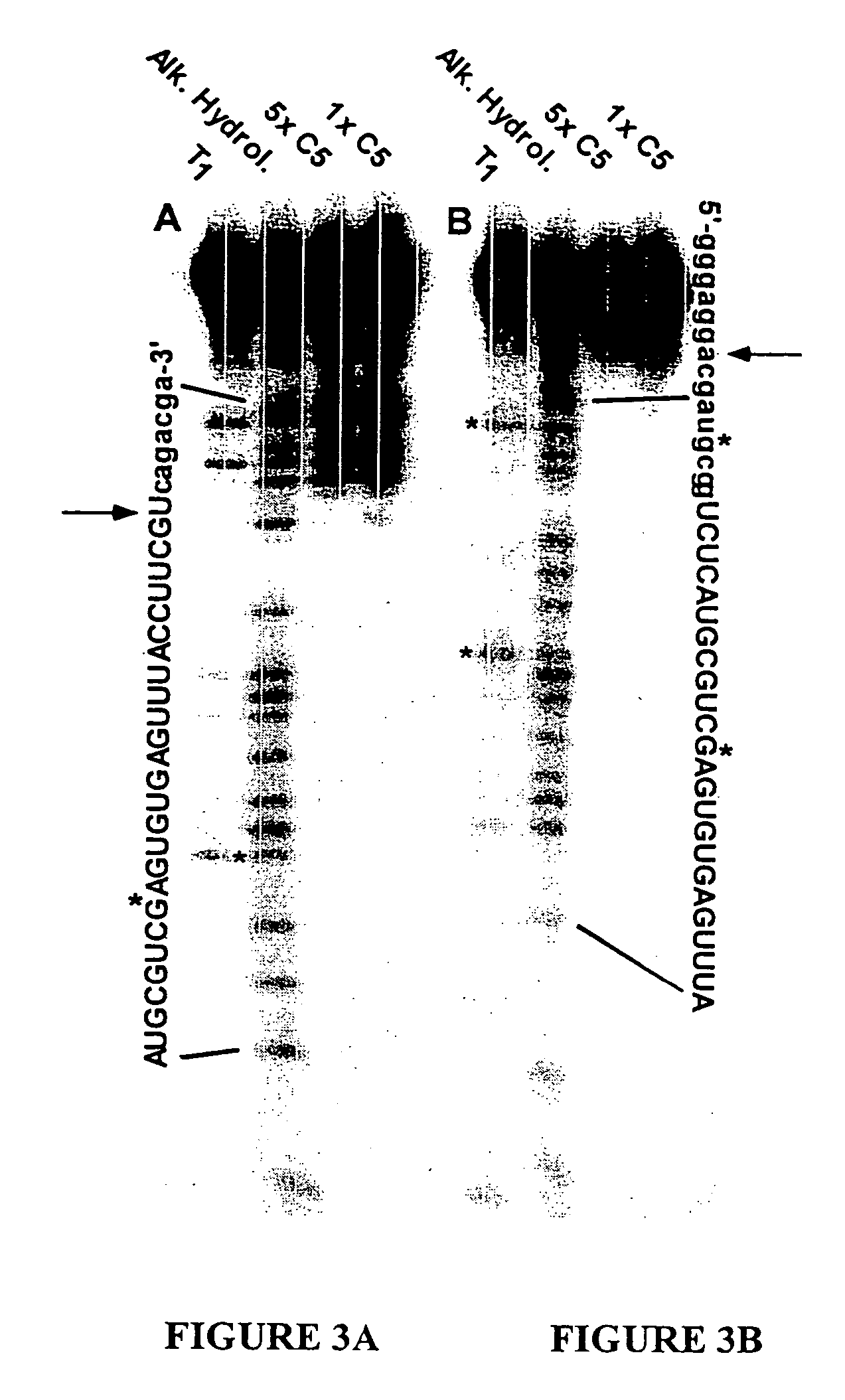High affinity nucleic acid ligands of complement system proteins
- Summary
- Abstract
- Description
- Claims
- Application Information
AI Technical Summary
Benefits of technology
Problems solved by technology
Method used
Image
Examples
example 1
Experimental Procedures
[0080] This example provides general procedures followed and incorporated in Examples 2, 3, 4 and 6 for the identification of 2′-NH2 and 2′-F RNA ligands to C1q, and 2′-F ligands to C3 and C5.
[0081] A. Biochemicals
[0082] C1q, C3, C5 and C4-deficient guinea pig sera were obtained from Quidel (San Diego, Calif.). Bovine serum albumin (BSA), rabbit anti-BSA, CRP, SAP and β-amyloid peptides 1-40 and 1-42 were obtained from Sigma (St. Louis, Mo.). Nucleotides GTP, ATP and deoxynucleotides were obtained from Pharmacia (Uppsala, Sweden). Taq polymerase was obtained from Perkin-Elmer (Norwalk, Conn.). Modified nucleotides 2′-NH2-CTP and 2′-NH2-UTP, and 2′-F-CTP and 2′-F-UTP, were prepared as described in Jellinek et al. (1995) Biochem. 34:11363. Avian reverse transcriptase was obtained from Life Sciences (St. Petersburg, Fla.) and T7 RNA polymerase from USB (Cleveland, Ohio). Nitrocellulose filters were obtained from Millipore (Bedford, Mass.). All chemicals were t...
example 2
2′-NH2 RNA Ligands to C1q
[0097] A. RNA SELEX
[0098] The pool of random 50N7-2′-NH2 RNA bound to C1q by nitrocellulose filter assay with a Kd of 2.3 μM. For round 1 of the SELEX process, the C1q concentration was between 0.156-1.25 μM and the RNA concentration was 15 μM. Throughout the SELEX process, the RNA concentrations were maintained at approximately 10-fold greater than the concentration of C1q, which was reduced at each round with a final round 14 C1q concentration of 136 pM. Background binding of RNA to nitrocellulose filters remained low throughout the SELEX procedure, in part because RNA was pre-adsorbed with nitrocellulose filters. The binding of pool RNA to C1q improved at each round. The evolved round 14 pool 2′-NH2 RNA bound C1q with a Kd=670 pM, yielding an overall improvement in binding Kd of 3400-fold.
[0099] Bulk RNA was then cloned for sequence determination and evaluation of binding. Through comparison of binding at 0.1 and 0.5 nM C1q, individual clones were rank...
example 3
2′-Fluoro Nucleic Acid Ligands of Complement System Protein C3
[0104] In order to generate ligands to complement protein C3, a library of about 1014 RNA was generated that contained 30 nucleotides of contiguous random sequence flanked by defined sequences. In this experiment, 30N random nucleotides of the initial Candidate Mixture were comprised of 2′-F pyrimidine bases. The rounds of selection and amplification were carried out as described in Example 1 using art-known techniques. In round 1 the 30N7-2′-F-RNA and C3 were both incubated at 3 μM. There was barely detectable binding at this round. Both the RNA and C3 concentrations were decreased during the SELEX procedure. Sequences derived from the SELEX procedure are shown in Table 3 (SEQ ID NOS:21-46).
PUM
| Property | Measurement | Unit |
|---|---|---|
| Mass | aaaaa | aaaaa |
| Mass | aaaaa | aaaaa |
| Mass | aaaaa | aaaaa |
Abstract
Description
Claims
Application Information
 Login to View More
Login to View More - R&D
- Intellectual Property
- Life Sciences
- Materials
- Tech Scout
- Unparalleled Data Quality
- Higher Quality Content
- 60% Fewer Hallucinations
Browse by: Latest US Patents, China's latest patents, Technical Efficacy Thesaurus, Application Domain, Technology Topic, Popular Technical Reports.
© 2025 PatSnap. All rights reserved.Legal|Privacy policy|Modern Slavery Act Transparency Statement|Sitemap|About US| Contact US: help@patsnap.com



